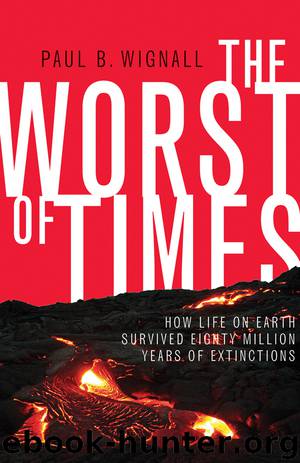The Worst of Times by Paul B. Wignall

Author:Paul B. Wignall
Language: eng
Format: epub
Publisher: Princeton University Press
Published: 2015-05-20T16:00:00+00:00
THE SMITHIAN/SPATHIAN EXTINCTION
The Smithian and Spathian are the third and fourth stages of the Early Triassic respectively, and their boundary, around 2 million years after the Permo-Triassic boundary, marks what appears to have been another terrible crisis for life. For obvious reasons it has acquired the rather sinister-sounding names of the S/S crisis or S/S extinction. The victims were not especially numerous or diverse, because life, especially on the seabed, had barely begun to recover from the previous mass extinction—in other words, there was not a lot around to kill at this time. However, many of the groups that had thrived post mass extinction succumbed during the S/S event. The mollusk victims included the bellerophontids, an unusual group of snails that had thrived in the earliest Triassic, and several types of bivalve. The ammonoids once again underwent a drastic pruning of their evolutionary tree at the end of the Smithian although, as usual, they bounced back very quickly. The conodonts were also victims. They had done well at the end of the Permian, but they then suffered devastating losses at the S/S boundary, almost to the point of being wiped out; however, the latter fate would not occur until the end of the Triassic.
On land the S/S extinction has not been studied in detail, but it appears that Lystrosaurus may have died out at this time. Among plants, the clearest changes seem to have occurred during the Spathian Stage, immediately after the extinction. Thus, high-latitude areas saw the reestablishment of gymnosperm woodland—trees were back. The contemporaneous sections in South China similarly record a change from a low-diversity flora dominated by herbaceous lycopsids and mosses to a woodland flora dominated by conifers. However, no such change is seen in central European areas, where the tough, lycopsid shrub Pleuromeia continued to thrive, to the near-exclusion of all other plants, until the end of the Early Triassic.
The carbon and oxygen isotope changes around the S/S boundary show a series of changes that provide clues to the cause of the crisis. The 13C/12C ratio in limestones decreases significantly as the proportion of 12C becomes greater. It may be recalled that a similar trend was also seen during the Permo-Triassic mass extinction, but this time, the swing to light carbon values was even greater. The oxygen isotope record from conodonts shows a parallel shift to lighter values and indicates that sea-surface temperatures, which were already hot, got even hotter, reaching a scalding 40°C in the latest Smithian Stage. These trends all sound like the Permo-Triassic boundary changes all over again, albeit somewhat magnified, and the same culprit—Siberian volcanism with CO2 release—has generally been blamed once again. However, the detailed timing of the eruption history of the Siberian lavas has not yet been evaluated in detail, and so far the link between the S/S crisis and volcanism is best described as possible but unproven.14
Both the causation and the consequences of the S/S crisis are a little unclear and tricky to understand. Hot seawaters and widespread anoxia
Download
This site does not store any files on its server. We only index and link to content provided by other sites. Please contact the content providers to delete copyright contents if any and email us, we'll remove relevant links or contents immediately.
| Fossils | Game Theory |
| Genetics | Molecular Biology |
| Organic | Paleontology |
Sapiens: A Brief History of Humankind by Yuval Noah Harari(14221)
Sapiens by Yuval Noah Harari(5281)
Pale Blue Dot by Carl Sagan(4886)
Homo Deus: A Brief History of Tomorrow by Yuval Noah Harari(4801)
Livewired by David Eagleman(3663)
Origin Story: A Big History of Everything by David Christian(3633)
Brief Answers to the Big Questions by Stephen Hawking(3358)
Inferior by Angela Saini(3262)
Origin Story by David Christian(3133)
Signature in the Cell: DNA and the Evidence for Intelligent Design by Stephen C. Meyer(3057)
The Gene: An Intimate History by Siddhartha Mukherjee(3030)
The Evolution of Beauty by Richard O. Prum(2927)
Aliens by Jim Al-Khalili(2777)
How The Mind Works by Steven Pinker(2715)
A Short History of Nearly Everything by Bryson Bill(2616)
Sex at Dawn: The Prehistoric Origins of Modern Sexuality by Ryan Christopher(2472)
From Bacteria to Bach and Back by Daniel C. Dennett(2432)
Endless Forms Most Beautiful by Sean B. Carroll(2415)
Who We Are and How We Got Here by David Reich(2387)
